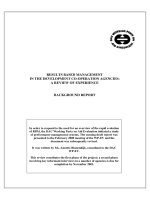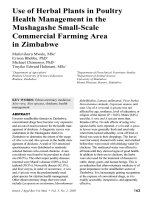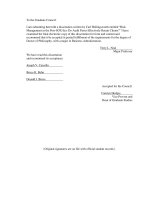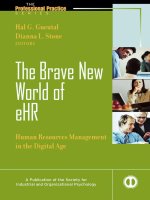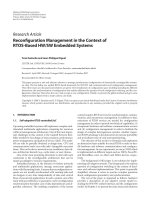Change management in the office of the ombudsman
Bạn đang xem bản rút gọn của tài liệu. Xem và tải ngay bản đầy đủ của tài liệu tại đây (1.97 MB, 212 trang )
Change Management in the Office of the Ombudsman
Rosanne Meehan
MBA (HRM)
April 2012
Change Management in the Office of the Ombudsman
Rosanne Meehan
MBA (HRM)
April 2012
Change Management in the Office of the Ombudsman
Submitted by:
Rosanne Meehan
Student Number:
1457657
Supervisor:
Chris McLaughlin
A dissertation submitted in part fulfilment of the requirements of the Masters in Business
Administration (Human Resource Management) to Dublin Business School and Liverpool
John Moore’s University
MBA (HRM)
April 2012
i
Declaration
I declare that all the work in this dissertation is entirely my own (with the exception of
specific sources that are referenced in the text and bibliography), no portion of the work
referred to in this dissertation has been submitted in support of an application for another
degree or qualification to any University or learning institution. Furthermore, all the work in
this dissertation is entirely my own.
Signed:
..........................................
Rosanne Meehan
Dated:
.......................................................
20 April 2012
ii
Dedication
This research paper is dedicated to my parents, John and Ann Meehan and my grandfather
James Renehan (RIP). Their belief that education begins in the heart of the home has
developed and encouraged me to continuously strive to reach my personal and professional
ambitions. They are my inspiration!
iii
Table of Contents
Declaration .............................................................................................................................ii
Dedication ............................................................................................................................ iii
Table of Contents .................................................................................................................. iv
List of Tables and Figures.................................................................................................. viii
List of Tables ................................................................................................................. viii
List of Figures ................................................................................................................ viii
Acknowledgements ................................................................................................................ x
Abstract ................................................................................................................................xii
Chapter 1: Introduction .............................................................................................................. 1
1.1
Organisation of the Dissertation .................................................................................. 1
1.2
Introduction to the Research ....................................................................................... 2
1.3
Background to the Research ........................................................................................ 2
1.4
Interest in the Subject and Justification for the Research ........................................... 4
1.5
Research Question ....................................................................................................... 5
1.6
Research Objective/Problem ....................................................................................... 6
Chapter 2: Literature Review ..................................................................................................... 8
2.1
Introduction ................................................................................................................. 8
2.2
Forces Driving Change.............................................................................................. 10
2.3
Importance of a Clear Strategy: Incorporating Change into the Mission, Identity and
Vision of the Organisation ................................................................................................... 14
2.4
Facilitating and Implementing Change ..................................................................... 16
2.5
Change Models .......................................................................................................... 20
2.6
Challenges to Change: Barriers and Resistance ........................................................ 25
2.7
Creating a Culture for Change .................................................................................. 28
2.8
Leading Change: Criteria for Managing Change ...................................................... 31
iv
2.9
Measuring Success: Communicating and Monitoring change .................................. 35
2.10
Summary................................................................................................................ 37
Chapter 3: Research Methodology........................................................................................... 39
3.1
Background ............................................................................................................... 39
3.2
Research Methodology.............................................................................................. 39
3.3
Research Philosophy ................................................................................................. 41
3.4
Research Approach ................................................................................................... 43
3.5
Research Strategy ...................................................................................................... 44
3.6
Research Choices ...................................................................................................... 45
3.7
Time Horizon ............................................................................................................ 46
3.8
Credibility and Reliability of Research Findings ...................................................... 46
3.9
Data Collection and Data Analysis ........................................................................... 48
3.10
Research Population and Sample .......................................................................... 49
3.10.1
Qualitative Data Collection................................................................................ 50
3.10.2
Quantitative Data Collection.............................................................................. 51
3.11
Limitations and Major Contributions of the Research .......................................... 55
3.12
Ethical Issues ......................................................................................................... 56
Chapter 4: Data Findings and Analysis ................................................................................... 59
4.1
Overview ................................................................................................................... 59
4.2
Qualitative Data Findings and Analysis .................................................................... 59
4.3
Quantitative Data Findings and Analysis .................................................................. 62
4.3.1
About You .......................................................................................................... 62
4.3.2
Forces Driving Change ...................................................................................... 63
4.3.3
The Strategy, Mission and Vision of the Office ................................................ 66
4.3.4
Structural and Process Changes ......................................................................... 69
4.3.5
Cultural Change ................................................................................................. 72
4.3.6
Change Management ......................................................................................... 74
v
4.3.7
Measurements for Success ................................................................................. 84
Chapter 5: Conclusion and Recommendations ........................................................................ 88
5.1
Conclusion................................................................................................................. 88
5.1.2
Limitations of the Research ............................................................................... 92
5.1.3
Further Research ................................................................................................ 93
5.2
Recommendations ..................................................................................................... 93
Chapter 6: Self Reflection ........................................................................................................ 96
6.1
Introduction ............................................................................................................... 96
6.2
Personal Background................................................................................................. 97
6.3
Learning Styles .......................................................................................................... 98
6.4
Reflections of Learning: Strengths and Key Skills Developed ............................... 100
6.4.1
People Management ......................................................................................... 100
6.4.2
Cognitive Skills................................................................................................ 100
6.4.3
Critical Skills ................................................................................................... 101
6.4.4
Inter-Personal Skills ......................................................................................... 101
6.5
Future Applications of Learning ............................................................................. 102
Bibliography .......................................................................................................................... 104
Appendix 1: Types of Change ........................................................................................... 112
Appendix 2: Effective Principles in the Design of HRM Systems .................................... 113
Appendix 3: The Organisational Iceberg ........................................................................... 114
Appendix 4: Table 2.4 Comparing Theories of Change .................................................... 115
Appendix 5: Media Selection Framework ......................................................................... 116
Appendix 6: Change Hierarchy Model: Critical Success Factors ..................................... 117
Appendix 7: The Five Components of Emotional Intelligence (EQ) at Work .................. 119
Appendix 8: Change Management: Focus and Methodologies ......................................... 120
Appendix 9: Example Measures for Change Management ............................................... 121
Appendix 10: Two Main Types of Philosophical Research Approaches .......................... 122
vi
Appendix 11 Interview with the Ombudsman ................................................................... 123
Appendix 12 Interview with the Director General, Office of the Ombudsman................. 136
Appendix 13 Interview with the Secretary General, Department of Defence ................... 146
Appendix 14 Interview with the Assistant Secretary General, Office of the Revenue
Commissioners................................................................................................................... 157
Appendix 15 Email Request and Reminder to Questionnaire Participants ....................... 169
Appendix 16 Questionnaire on Change Management within the Office of the Ombudsman
............................................................................................................................................ 171
Appendix 17 SWOT Analysis ........................................................................................... 188
Appendix 18 PESTLE Analysis......................................................................................... 190
Appendix 19 Cultural Web Analysis ................................................................................. 191
Appendix 20 Balanced Scorecard ...................................................................................... 193
Appendix 21 Four Orientations to Learning ...................................................................... 194
Appendix 22 Skills Sets ..................................................................................................... 195
Appendix 23 Career Objectives Tree ................................................................................. 196
Appendix 24 Characteristics of the Four Learning Styles ................................................. 197
Appendix 24 Personal SWOT Analysis ............................................................................. 198
vii
List of Tables and Figures
List of Tables
Table 1.1
Three year comparison of complaints................................................................3
Table 2.1
Set up for Success............................................................................................24
Table 6.1
Learning styles of the researcher over the course of the MBA (HRM)...........99
List of Figures
Figure 3.1
The Research Onion.........................................................................................41
Figure 3.2
Responses to Question 1..................................................................................53
Figure 3.3
Responses to Question 2..................................................................................53
Figure 3.4
Responses to Question 3..................................................................................54
Figure 3.5
Responses to Question 4..................................................................................54
Figure 4.1
Responses to Question 5..................................................................................62
Figure 4.2
Responses to Question 6..................................................................................63
Figure 4.3
Responses to Question 7..................................................................................64
Figure 4.4
Responses to Question 8..................................................................................64
Figure 4.5
Responses to Question 9..................................................................................65
Figure 4.6
Responses to Question 10................................................................................66
Figure 4.7
Responses to Question 11................................................................................66
Figure 4.8
Responses to Question 12................................................................................67
Figure 4.9
Responses to Question 13................................................................................68
Figure 4.10
Responses to Question 14................................................................................69
Figure 4.11
Responses to Question 15................................................................................70
Figure 4.12
Responses to Question 16................................................................................70
Figure 4.13
Responses to Question 17................................................................................71
Figure 4.14
Responses to Question 18................................................................................72
viii
Figure 4.15
Responses to Question 19................................................................................73
Figure 4.16
Responses to Question 20................................................................................73
Figure 4.17
Responses to Question 21................................................................................74
Figure 4.18
Responses to Question 22................................................................................75
Figure 4.19
Responses to Question 23................................................................................75
Figure 4.20
Responses to Question 24................................................................................76
Figure 4.21
Responses to Question 25................................................................................76
Figure 4.22
Responses to Question 26................................................................................77
Figure 4.23
Responses to Question 27................................................................................78
Figure 4.24
Responses to Question 28................................................................................78
Figure 4.25
Responses to Question 29................................................................................79
Figure 4.26
Responses to Question 30................................................................................80
Figure 4.27
Responses to Question 31................................................................................80
Figure 4.28
Responses to Question 32................................................................................81
Figure 4.29
Responses to Question 33................................................................................82
Figure 4.30
Responses to Question 34................................................................................82
Figure 4.31
Responses to Question 35................................................................................83
Figure 4.32
Responses to Question 36................................................................................84
Figure 4.33
Responses to Question 37................................................................................84
Figure 4.34
Responses to Question 38................................................................................85
Figure 4.35
Responses to Question 39................................................................................85
Figure 4.36
Responses to Question 40................................................................................86
Figure 4.37
Responses to Question 41................................................................................86
Figure 4.38
Responses to Question 42................................................................................87
Figure 6.1
Kolbs Learning Styles .....................................................................................97
Figure 6.2
Honey and Mumford (1986) learning styles....................................................99
ix
Acknowledgements
I would like to acknowledge and thank my parents, John and Ann Meehan, for their
unfaltering encouragement, commitment, and support throughout the course of my MBA
HRM. I couldn’t have done it without you both!
I would like to thank my brothers and sisters; David, Andrew, Paul, Caroline, Kevin and
Sarah and my extended family Jennie, Trish and Roy for their words of wisdom and support.
I would also like to thank my all my friends and colleagues for their support and kind wishes.
To my nieces (Hannah and Isabel) and nephews (Matthew and Jack), “We grow great by
dreams....... Some of us let these great dreams die, but others nourish and protect them; nurse
them through bad days till they bring them to the sunshine and light which comes always to
those who sincerely hope that their dreams will come true” (Woodrow Wilson, 1914).
I would like to thank my dissertation supervisor Chris McLaughlin for his guidance,
encouragement and support.
I would like to thank the Ombudsman, Director General of the Office of the Ombudsman,
Assistant Secretary General, Office of the Revenue Commissioners, and Director General,
Department of Defence, for the enormous support and encouragement I received from them,
and for the valuable insight I gained from their unquestionable experience and knowledge in
both the civil service and the area of change management.
I would like to thank all the staff in the Office of the Ombudsman for their commitment and
support in taking the time to complete the staff questionnaire and share their valuable
learning and experience with me. I would also like to thank Mr. Bernard Traynor, Mr. David
Glynn and Mr. Tony Hayden for their support and time.
Finally, I would like to thank all the staff in the Office of the Commission for Public Service
Appointments especially Mr. Danny Smith, Mr. Brendan O’Callaghan (RIP), Ms. Ann
Cullen, Mr. Richard Crowley and Ms. Elaine Laird for their belief in my professional
capabilities, and their continuous support and encouragement of learning and self
development as a corner stone to change and excellence in the civil service.
x
“The only constant is change”
(Heraclitus as quoted in Siegal and Stearn, 2010)
xi
Abstract
The concept of change management has been evident for centuries. However, it has
dramatically increased in the twenty first century as forces driving change are evolving at an
increasing speed and the effects of a worldwide recession can be felt. Throughout the years
organisations have put in place various methods and methodologies to manage change which
include; structural, process and technological change. However, it is interesting to note that
despite the fact that change is a topical subject amongst academics and consultants, only one
third of all change initiatives succeed. Although there is no one model to ‘fit’ all
organisations, given the increasing factors influencing Irish public sector transformation and
the lack of academic research in this area to-date, it is hoped that this study will assist change
projects in the Irish public service. This research study of change centres on the area of
change management using a specific case study to investigate structural and process change
carried out in the Office of the Ombudsman. The goal of the study is to establish; the forces
driving change, changes, if any, to the organisation’s strategy, vision and mission, how the
two types of change were facilitated and implemented, if the Office experienced any
resistance to change and how this was overcome, if the change has impacted on the
organisations culture, factors associated with the effective management of change, and the
measurements for success and if they are being achieved. Through a mixed method approach
the researcher established that it was the intention of the Office to improve its efficiency and
efficacy through structural and process change. Throughout the study the researcher
discovered that employees were highly aware of the need for change, however, it was
established that communication could have been improved as this caused feelings of lack of
support. That said, although these weaknesses were present, the restructuring of the structure
and processes within the Office were implemented successfully and the results are self
evident. Finally, as the changes were implemented on 1 March 2011, it is too early to state
whether long-term change is evident in its culture.
xii
Chapter 1: Introduction
1.1
Organisation of the Dissertation
The dissertation commences with Chapter 1 which seeks to introduce the topic of discussion
and provide a preliminary comprehension to the research problem and hypothesis whilst,
providing a brief outline of the aims and objectives of the study and the organisation within
which the research is being conducted. In unison with this the researcher will introduce the
organisations which have participated in the research. The researcher will provide the reasons
behind the research methodology utilised throughout this study, discussing the methodology
and philosophy appropriate to collect the data from the research participants in this case
study. An overview of the researchers’ interest in the research problem will also be
highlighted.
In Chapter 2, the Literature Review, the researcher critically accesses academic
literature/reviews with the intention of exploring the range of academic thought in the area of
change management. Fundamentally, the review will provide an overview of core areas of
debate within change management. This is carried out with the intention of gaining an
appreciation of the reasoning behind the strategic choices deemed appropriate by the public
sector organisation.
Chapter 3, Analysis of the research data collated during the study and a discussion based on
the findings.
Chapter 4, Concludes the research study by summarising the key aspects of research based on
the literature review, methodology and data analysis. Thereafter, the researcher will present
recommendations based on the conclusion of the research study.
Chapter 5, Self-reflection, an evaluation and comprehension of particular learning
experiences, throughout the research study, which have enabled the researcher to enhance and
develop certain indispensable skills, applicable to the wider spectrum.
1
1.2
Introduction to the Research
“Change is endemic in both private and public lives.” (Dover, 2002)
In recent years, modernisation of the Civil Service and its agents has become a necessity if
management structure, processes, decision-making and leadership roles are to be improved
and implemented across several tiers of Government Departments and agencies. There is
however, a unique level of complexity as effective decision making and leadership, across
many tiers, is complicated by the need to balance political, leadership and managerial
priorities under the scrutiny of the public, unions, legislation, policies and media. In the past,
change management plans and government reform agendas in various countries, despite good
intentions’, failed, due to plans being too slow to commence and agendas taking too long to
implement. Therefore, the achievements within an expanded timeframe were minimal and
outweighed by the costs. As a result, the focus of this research problem area is on the
investigation of change and change management in the context of Structural change
(authority relationships, coordinating relationships, job redesign and spans of control) and
people change (attitudes, expectations, perceptions and behaviours) within the Office of the
Ombudsman.
1.3
Background to the Research
In 1908, the King of Sweden appointed the first Ombudsman, meaning ‘agent’ or
‘representative’ of the people, to investigate complaints against the Kings Ministers.
However, it was not until 1952 in Denmark that the idea of an Ombudsman’s Office was
established and the idea began to gain momentum and expand into other areas of Europe and
the World. Today, there are approximately 120 Ombudsman Offices Worldwide.
Legislation setting up an Irish Ombudsman was enacted under the Ombudsman Act, 1980.
Under this law the first Irish Ombudsman took up office in 1984, after he was appointed by
the President on the recommendation of the Dáil and the Seanad. The current Ombudsman,
Ms. Emily O’Reilly took up office in June 2003 and in June 2009, she was appointed to a
subsequent six year term as Ombudsman.
2
The Ombudsman’s role includes the examination of complaints relating to administrative
actions of Government Departments, the Health Service Executive (HSE), Local Authorities
and An Post. Furthermore, the Ombudsman’s primary concern is to ensure that any action
performed by a public body under his/her remit is executed in a reasonable and fair manner.
The Office of the Ombudsman was established on 7 July 1983 to assist the Ombudsman in
the execution of his/her role in examining complaints made to him/her by members of the
public. The service provided by the Office includes an independent complaint’s examination
service to members of the public that feel aggrieved by the actions of a public body and have
suffered as a result. The Ombudsman Act, 1980, also sets out the powers of the Ombudsman
as regards the examination and investigation of complaints.
As stated in the Office of the Ombudsman’s Customer Charter, the Office is committed to
providing a high standard of service to all clients which, will be performed in accordance
with “The Ombudsman’s Principles of Good Administration” and in accordance with the
principles of Quality Customer Service approved by Government. The client charter sets out
the standards of service the Office aims to provide to clients including; individual
complainants and their representatives, elected representatives (such as T.D.’s, Senators),
Local Authorities and their members, Government Departments/Offices, the HSE, and many
voluntary and representative bodies and organisations. The Office also aims to measure and
evaluate its performance against these standards and to report on its performance in its
Annual Report published yearly. The table below adapted from the Ombudsman’s Annual
Report 2010 demonstrates a three year comparison of complaints received, that were within
remit (excluding complaints received under the Disability Act, 2005). In denotes a significant
increase in the number of complaints received by the Ombudsman’s Office in recent years.
Table 1.1 Three year comparison of complaints as adapted from the Ombudsman’s
Annual Report 2010
Three year comparison of complaints received within the Ombudsman’s remit
2010
3,720
2009
2,867
2008
2,781
3
In the past, the Office of the Ombudsman functioned with four divisions: Local Authorities,
Government Departments, Social welfare and Health and Social Care. Within these divisions
teams
comprised
of
an
Assistant
Principal
(Investigator),
a
Higher
Executive
Officer/Executive Officer and a Clerical Officer. These teams processed complaints received
from the public and dealt with a complaint from start to finish.
However, given the exceptional and challenging increase in complaints a structural and
process transformation was implemented on the 1 March 2011. The new structure and
processes dissolved divisions and team roles. Now, each employee is recruited into sections
which, process all complaints (Local Authorities, Civil Service, Social Welfare and HSE) up
to a certain level. These levels include Enquiries (all new complaints/enquiries are processed
here), Assessments (all valid complaints filtered by the enquiries section are dealt here),
Examination (difficult complaints are examined here which, take longer than 2-3 hours to
process) and finally Investigations (cases that require investigations are dealt with here). High
profile examples include: the Lost at Sea and Who Cares Reports).
1.4
Interest in the Subject and Justification for the Research
“It is not the strongest of the species that survive, nor the most intelligent, but the one most
responsive to change” (Charles Darwin)
The topic of change management is of particular interest to the researcher for two distinctive
reasons. Firstly, the researcher commenced employment in the Civil Service as a Clerical
Officer in the Office of the Commission for Public Service Appointments in June 2006 and in
October 2010 the researcher, now an Executive Officer, working in the Office of the
Ombudsman as part of a merger of the two organisations, in line with the McCarthy Report
recommendations. As part of the Office of the Ombudsman’s staffing, the researcher was
now involved in the preparation and subsequent implementation of change being rolled out
within the Office. The Office of the Ombudsman implemented the structural and process
changes on 1 March 2011. The level of change within the organisation was quite radical and
the researcher had a unique opportunity to analyse the changes, resistance to change and
cultural changes from an external observer’s perspective whilst working in the heart of the
organisation. A rare opportunity to be seized!
4
Secondly, the researcher’s interest in the area was encouraged and nurtured by lecturers
whom provided personal experience and academic insight in the area. As a result, the
researcher has been closely involved in the change management process having been afforded
an opportunity to observe, participate and analyse the different stages of the change
transformation. In this regard, the researcher is now in a position to reflect on the process as a
whole, as an objective observer.
In this study, it is the aim of the researcher to investigate what lessons can be drawn from a
public sector change initiative. Continuous learning throughout the course has given the
researcher the skills required to research and analyse the theory related to change
management and apply the theory to practices carried out by the Office of the Ombudsman.
Ultimately, the main purpose of the academic research and collation of objective data is to
add value to the existing literature on change management in the field of public sector change
management. Objectively speaking, throughout the vast opportunities in the past and the
present turmoil facing many civil and public sector organisations, change has been the only
constant. However, successful change can be difficult to achieve especially when the
financial markets are experiencing historic downturns and global confusion. It is easy for
public sector organisations to become entranced in the voluminous array of literature in the
field. Nevertheless, case studies of public sector change management in Ireland are scarce, if
existent. In light of this, the core of the research is to establish and provide an insight and
understanding of how the transformation process in the Office of the Ombudsman can
potentially open avenues and provide an insight and understanding of how the transformation
process can be utilised by other Government departments/offices seeking to implement
change given the current economic turmoil.
1.5
Research Question
Change is the one constant in an ever diversifying world. The process of change itself has
assumed many titles; change management, organisational transformation, restructuring,
reengineering, turnaround, total quality management. However, as stated by Kotter (1995), in
almost every change initiative the basic goal has remained the necessity to make principal
changes in how business is carried out in order to manage a new, more challenging and
diversifying business environment.
5
That said, almost 70% of change initiatives fail (Kotter, 1995). Given the vast array of
research and publications in the area of change management it is interesting to note that few
researchers can agree on the major factors critical to the success of change initiatives (Sirken
et al., 2005).
In this regard, the research question of this case study focuses on: what were the driving
forces behind the idea of change within the Office of the Ombudsman, why did it
change its structure and culture, how did it manage the change management process,
what were the measures of success and were the measurements for success achieved?
Further broken down, the researcher as part of the dissertation will establish the following:
1. driving forces behind the change – why?,
2. understanding the change management process – both structural and cultural,
3. management of the change management process – how?,
4. was it a success – measurements for success?, and
5. risk of failure – how to address this? – observation and correction.
Following on from this the aim of the dissertation is also to establish the truth behind the
subsequent hypothesis:
•
A clear vision and business strategy communicated and driven by senior management
is critical to the successful long-term implementation of change.
1.6
Research Objective/Problem
The aim of the dissertation is to investigate many aspects associated with change
management. In this regard, the research objectives are to:
1. identify the forces driving change and establish why the Office decided to change,
2. establish the changes, if any, to the strategy, mission, identity and vision of the
Organisation and how they were implemented,
3. establish how the two categories of change (structure and process) were facilitated
and implemented,
6
4. establish if there was resistance to change and, if so, how this was overcome,
5. establish if the change process is effecting the Organisations culture,
6. determine if the factors associated with the effectiveness criteria for managing change
are being met, and
7. determine the measurements for success and if they are being achieved.
In summary, the aims of the research objectives, with regard to the Office of the Ombudsman
are to: establish models which aided the conception and understanding of change, define any
tools and techniques that helped in planning and delivering change within the Office and
determine if lessons learnt through the implementation phase were used to avoid unforeseen
pitfalls (Newton, 2011). In conclusion, there is no one change model to ‘fit’ all organisations,
however, it is envisaged that the research will contribute to previous studies conducted in the
area of Irish public sector change management.
7
Chapter 2: Literature Review
2.1
Introduction
“Change is a persuasive influence. We are all subject to continual change of one form or
another. Change is an inescapable part of both social and organisational life” (Mullins,
2002)
Change management literature focuses on the one constant which is the fact that, change is
the only certainty in an ever diversifying world. However, the idea of change itself is
changing (Abrahamson, 2000) and the speed at which change takes place or is necessary has
increased significantly since the Industrial Revolution of the eighteenth century (Baker,
2007). All organisations now need to be proactive, responsive and responsible to survive in
today’s market (Manikandan, 2010).
Kee and Newcomer (2008) state that since the early 1980’s, the challenges facing public
sector organisations have diversified significantly as the present environment is unpredictable
and dynamic, and they are increasingly decentralised. Any change in the public sector must
be implemented in line with external forces such as social, economic and political factors
whilst, maintaining the values and norms that are consistent with the public interest. These
are in essence the guiding values for public sector leaders embracing change. In tandem with
this, public sector organisations have adapted a vast range of flexible and accommodating
work practices in accordance with administrative change initiatives (Song, 2009). Vallas
(2003) indicates that bureaucratic organisational structures are changing their flexibility and
adaptability in accordance with current economic conditions. As stated by Chandler (2003)
“Structure follows strategy”.
At present a major trigger of change within the Public Sector is the turbulence of the
recession and the need to anticipate and embrace change constructively and creatively
(Baker, 2007). These triggers can arise outside or inside an organisation, indicating that
current arrangements, systems, procedures, rules and other aspects of an organisations’
structure and process are no longer appropriate or effective (Buchanan and Huczynski, 1997).
8
According to Kimberly and Miles (1980) life cycle theory indicates that structural change
accompanies an organisations growth. On the contrary, Burke and Litwin (1992) state that
organisations change as a result of mission, strategy, system and structure. However, it is
widely agreed that the capacity to predict and plan organisational change ensures a greater
chance of implementing successful change which, includes a positive effect on individual
employee development and organisational performance (Weir, 1996; Robertson and
Seneviratne, 1995)
Therefore, success isn’t possible without changing the day-to-day behaviour of a company
and change should include focusing employee’s minds to their own insights by facilitating
entrepreneurial and positive discussions and activities (Rock et al., 2006; Nonaka, 2007).
Following on from the resource-based view (Priem et al., 2001; Barney, 1996), it is time
organisations started treating their organisations as living organisms that have the ability to
be: adaptive, flexible, self-renewing, resilient, learning and intelligent – attributes found only
in living things (Wheatley et al., 1996; Nonaka, 2007). Furthermore, many academics in the
field believe that change comes in many different forms. Sometimes it is merely structural,
requiring reorganisation of activities or the introduction of new people into particular roles
(change agents who encourage and manipulate the acceptance of change (Jackson, 2010). At
other times cultural change is sought in order to alter attitudes, philosophies or long-present
organisational norms” (Torrington et al., 2008). Nonetheless, Kotter (1995) reported that
from 1985-1995 he monitored more than 100 companies implementing change of which, over
50% of the companies monitored failed in the first phase of change implementation.
What is interesting is the fact that in 1996, only 30 percent of change programs succeeded
(Aiken et al, 2009). In 2010, this figure remains unchanged (Manikandan, 2010). Therefore,
despite decades of study of change management disciplines, leading scholars writings, and
legions of consultants depicting their methodologies, change initiatives are decreasing in
popularity as it fails to produce sustainable changes in; process, behaviour, performance and
ultimately the essential nature of the organisation (Roberto and Levesque, 2005).
9
2.2
Forces Driving Change
“The forces that operate to bring about change in organizations can be thought of as winds
which vary from warm summer breezes that merely disturb a few papers to hurricanes that
cause devastation to structures and operations that require reorientation of purpose and
rebuilding. Sometimes, the winds subside to give periods of relative calm and organizational
stability” (Senior and Swailes, 2010).
Change (transformation) occurs in epic proportions throughout the western society every
century, and within a matter of decade’s society itself changes not only its basic values and
social and political structures but also its institutions (Drucker, 1997). As stated by Quinn et
al. (1998) in the post industrial era intellectual capital and systems capability will determine
the success of an organisation. Drucker (1997) argues that knowledge itself is changing and
evolving at a rapid pace whereby, organisations must be organised for constant upending
change. The dominant view indicates that this is advisable not only for organisations but also
individuals should they wish to enhance and acquire new knowledge every 4 to 5 years or
face becoming institutionalised, uncreative and outdated (Davenport et al., 1998; Quinn et al.,
1998; Porter and Millar, 1985; Nonaka, 2007).
Therefore, in a society where the only certainty is uncertainty, successful companies will
need to create new knowledge, disseminate it widely throughout the organisation and rapidly
envelope and embody new technologies (Nonaka, 2007; Porter and Millar, 1985). In this
regard, as stated by Hemp (2009) “in the knowledge economy, information is our most
valuable commodity”, it is the new primary resource (Rayport and Sviokla, 1996) and it has
undoubtedly lead to learning organisations (Quinn et al, 1998). Information is leveraged
through advances in technology (Davenport, 2006) and the virtual value chain whereby, value
adding steps are virtual as they are performed through and with information (Rayport and
Sviokla, 1996). In addition, the increase in networked computers has enabled organisations to
codify, store, and share knowledge more easily and cheaper than ever before (Hansen et al.,
1999; Porter and Miller, 1985; Teece, 1998). Furthermore, Prahalad and Hamel (1990) argue
that, the greatest source of advantage is found in management’s ability to merge technologies
and organisational skills into competencies that empower organisations to adapt quickly to
changing opportunities.
10
Quinn et al. (1998) believe that professional intellect comprises four levels; cognitive
knowledge (know-what), advanced skills (know-how), systems understanding (know-why)
and self-motivated creativity (care-why). They argue that managing human intellect alone is
not enough. However, through new technologies and management approaches such as;
software tools, incentive systems, and specifically designed/re-designed organisational
structures, professional intellect can be leveraged to higher levels.
According to Nonaka (2007) competitive advantage through new knowledge and innovation
derives not only from the processing of objective information but more importantly the
ability to embrace and utilise tacit knowledge. Nonaka (2007) defines tacit knowledge as
highly subjective insights, intuitions, and haunches of individuals. Consequently, it is widely
agreed (Nonaka, 2007; Quinn et al., 1998; Hansen et al., 1999; Drucker, 1992) that
organisations must acquire individual employees’ tacit knowledge and make it available for
testing and use by the company as a whole. Consequently, it is agreed that the key to
acquiring, developing and utilising this resource is the personal commitment of individual
employee’s and the ability to enhance their sense of identity with the organisation and its
mission.
Contrary to prior misconceptions Nonaka (1997) highlights that, the distinction between tacit
and explicit knowledge implies four basic patterns for creating knowledge; tacit to tacit, i.e.
learning tacit skills through socialisation (observation, imitation, etc,), explicit to explicit, i.e.
gathering knowledge/information from throughout an organisation and collating/synthesising
this data creating new knowledge, tacit to explicit, i.e. the ability to articulate the foundations
of one’s own tacit knowledge and converting it into explicit knowledge, and explicit to tacit,
i.e. the sharing of knowledge throughout an organisation and an employee’s ability to
internalise it by broadening and reframing their individual tacit knowledge.
Hansen et al. (1999) argue that information technology can be leveraged to capture and
disseminate knowledge. However, they argue that there are two knowledge management
strategies, the codification strategy and the personalisation strategy. The codification strategy
occurs when knowledge is carefully codified and stored in databases to be accessed and
exploited by all employees within an organisation.
11
